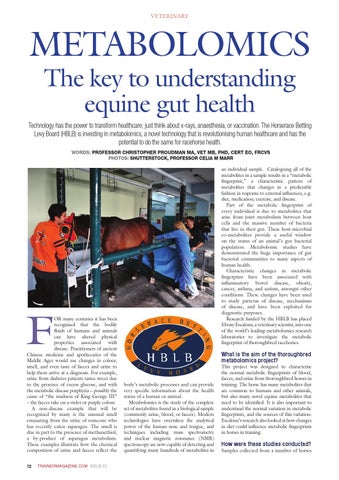VETERINARY
METABOLOMICS The key to understanding equine gut health
Technology has the power to transform healthcare; just think about x-rays, anaesthesia, or vaccination. The Horserace Betting Levy Board (HBLB) is investing in metabolomics, a novel technology that is revolutionising human healthcare and has the potential to do the same for racehorse health. WORDS: PROfeSSOR ChRiStOPheR PROuDman ma, Vet mB, PhD, CeRt eO, fRCVS PhOtOS: ShutteRStOCk, PROfeSSOR Celia m maRR
an individual sample. Cataloguing all of the metabolites in a sample results in a “metabolic fingerprint,” a characteristic pattern of metabolites that changes in a predictable fashion in response to external influences, e.g. diet, medication, exercise, and disease. Part of the metabolic fingerprint of every individual is due to metabolites that arise from joint metabolism between host cells and the massive number of bacteria that live in their gut. These host-microbial co-metabolites provide a useful window on the status of an animal’s gut bacterial population. Metabolomic studies have demonstrated the huge importance of gut bacterial communities to many aspects of human health. Characteristic changes in metabolic fingerprint have been associated with inflammatory bowel disease, obesity, cancer, asthma, and autism, amongst other conditions. These changes have been used to study patterns of disease, mechanisms of disease, and have been exploited for diagnostic purposes. Research funded by the HBLB has placed Ebony Escalona, a veterinary scientist, into one of the world’s leading metabolomics research laboratories to investigate the metabolic fingerprint of thoroughbred racehorses.
F
OR many centuries it has been recognised that the bodily fluids of humans and animals can have altered physical properties associated with disease. Practitioners of ancient Chinese medicine and apothecaries of the Middle Ages would use changes in colour, smell, and even taste of faeces and urine to help them arrive at a diagnosis. For example, urine from diabetes patients tastes sweet due to the presence of excess glucose, and with the metabolic disease porphyria – possibly the cause of “the madness of King George III” – the faeces take on a violet or purple colour. A non-disease example that will be recognised by many is the unusual smell emanating from the urine of someone who has recently eaten asparagus. The smell is due in part to the presence of methanethiol, a by-product of asparagus metabolism. These examples illustrate how the chemical composition of urine and faeces reflect the
72
TRAINERMAGAZINE.COM ISSUE 53
What is the aim of the thoroughbred metabolomics project?
body’s metabolic processes and can provide very specific information about the health status of a human or animal. Metabolomics is the study of the complete set of metabolites found in a biological sample (commonly urine, blood, or faeces). Modern technologies have overtaken the analytical power of the human nose and tongue, and techniques including mass spectrometry and nuclear magnetic resonance (NMR) spectroscopy are now capable of detecting and quantifying many hundreds of metabolites in
This project was designed to characterise the normal metabolic fingerprints of blood, faeces, and urine from thoroughbred horses in training. The horse has many metabolites that are common to humans and other animals, but also many novel equine metabolites that need to be identified. It is also important to understand the normal variation in metabolic fingerprints, and the sources of this variation. Escalona’s research also looked at how changes in diet could influence metabolic fingerprints in horses in training.
How were these studies conducted?
Samples collected from a number of horses
